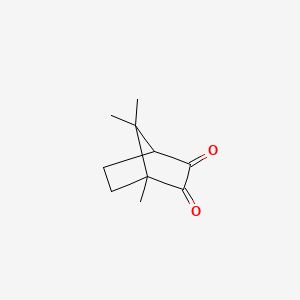| MeSH term | MeSH ID | Detail |
|---|---|---|
| Hemolysis | D006461 | 131 associated lipids |
| Dental Leakage | D003763 | 5 associated lipids |
| Body Weight | D001835 | 333 associated lipids |
Camphorquinone
Camphorquinone is a lipid of Prenol Lipids (PR) class. The involved functions are known as Polymerization. The related lipids are camphoroquinone.
Cross Reference
Introduction
To understand associated biological information of Camphorquinone, we collected biological information of abnormalities, associated pathways, cellular/molecular locations, biological functions, related genes/proteins, lipids and common seen animal/experimental models with organized paragraphs from literatures.
What diseases are associated with Camphorquinone?
There are no associated biomedical information in the current reference collection.
Possible diseases from mapped MeSH terms on references
We collected disease MeSH terms mapped to the references associated with Camphorquinone
PubChem Associated disorders and diseases
What pathways are associated with Camphorquinone
There are no associated biomedical information in the current reference collection.
PubChem Biomolecular Interactions and Pathways
Link to PubChem Biomolecular Interactions and PathwaysWhat cellular locations are associated with Camphorquinone?
There are no associated biomedical information in the current reference collection.
What functions are associated with Camphorquinone?
Related references are published most in these journals:
| Function | Cross reference | Weighted score | Related literatures |
|---|
What lipids are associated with Camphorquinone?
Related references are published most in these journals:
| Lipid concept | Cross reference | Weighted score | Related literatures |
|---|
What genes are associated with Camphorquinone?
There are no associated biomedical information in the current reference collection.
What common seen animal models are associated with Camphorquinone?
There are no associated biomedical information in the current reference collection.
NCBI Entrez Crosslinks
All references with Camphorquinone
Download all related citations| Authors | Title | Published | Journal | PubMed Link |
|---|---|---|---|---|
| Musanje L et al. | Determination of the optimal photoinitiator concentration in dental composites based on essential material properties. | 2009 | Dent Mater | pmid:19328539 |
| Can-Karabulut DC et al. | Adhesion to primary and permanent dentin and a simple model approach. | 2009 | Eur J Dent | pmid:19262729 |
| Ikemura K et al. | UV-VIS spectra and photoinitiation behaviors of acylphosphine oxide and bisacylphosphine oxide derivatives in unfilled, light-cured dental resins. | 2008 | Dent Mater J | pmid:19241683 |
| Sengun A et al. | Adhesion of two bonding systems to air-abraded or bur-abraded human enamel surfaces. | 2008 | Eur J Dent | pmid:19212543 |
| Sehgal A et al. | Evaluation of the effects of the oxygen-inhibited layer on shear bond strength of two resin composites. | 2008 | J Conserv Dent | pmid:20351974 |
| Hegde MN et al. | The influence of salivary contamination on the shear bond strength of two newer generation dentin bonding agents - An in vitro study. | 2008 | J Conserv Dent | pmid:20142900 |
| Ilie N and Hickel R | Can CQ be completely replaced by alternative initiators in dental adhesives? | 2008 | Dent Mater J | pmid:18540396 |
| Hegde MN et al. | Evaluation of depth of cure and knoop hardness in a dental composite, photo-activated using different methods. | 2008 | J Conserv Dent | pmid:20142889 |
| Hegde MN and Bhandary S | An evaluation and comparison of shear bond strength of composite resin to dentin, using newer dentin bonding agents. | 2008 | J Conserv Dent | pmid:20142888 |
| Prakki A et al. | In vitro wear, surface roughness and hardness of propanal-containing and diacetyl-containing novel composites and copolymers based on bis-GMA analogs. | 2008 | Dent Mater | pmid:17688931 |
